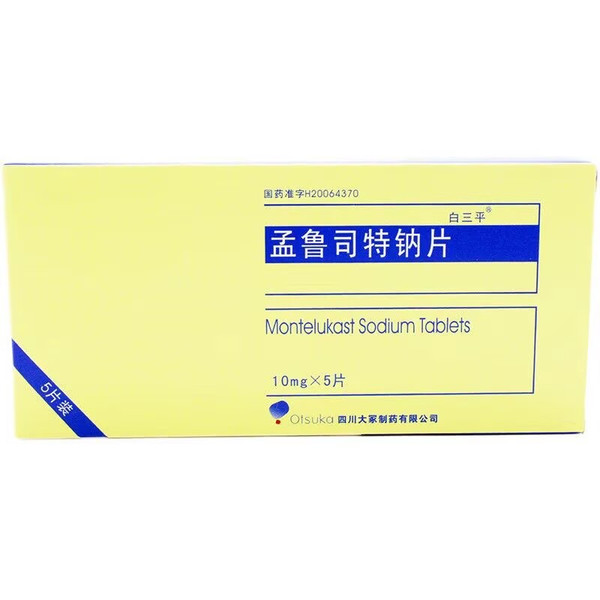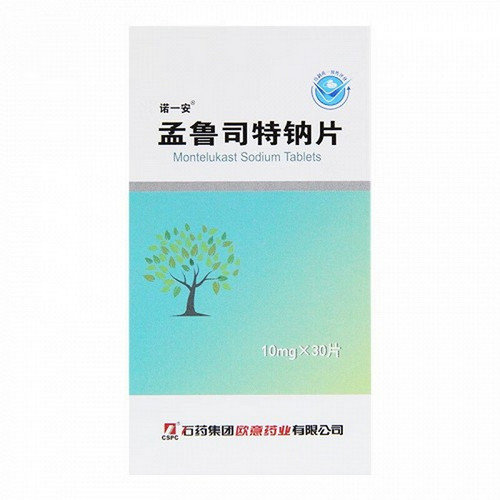Product Overview
[Drug Name]
Generic Name: Montelukast Sodium Tablets
Trade Name: Bai San Ping
English Name: Montelukast Sodium Tablets
Chinese Pinyin: Menglusitena Pian
[Ingredients]
The main ingredient of this product is: Montelukast sodium.
[Properties]
This product is a film-coated tablet that appears white or off-white after removal of the coating.
[Indications]
This product is indicated for the prevention and long-term treatment of asthma in adults aged 15 years and older, including prevention of daytime and nighttime asthma symptoms, treatment of aspirin-sensitive asthma, and prevention of exercise-induced bronchoconstriction. This product is indicated for adults aged 15 years and older to relieve symptoms of seasonal allergic rhinitis.
[Dosage and Administration]
One tablet (10 mg) once daily. Asthma patients should take the tablet at bedtime. Patients with allergic rhinitis may take the tablet as needed based on their condition. Patients with both asthma and allergic rhinitis should take the tablet once nightly. Adult patients 15 years and older with asthma and/or allergic rhinitis should take 10 mg once daily. It is generally recommended that asthma control indicators be used to evaluate therapeutic efficacy, and the effectiveness of this product is apparent within one day of medication. This product can be taken with or without food. Patients should be advised to continue taking this product regardless of whether their asthma is under control or exacerbated. No dosage adjustment is required for elderly patients, those with renal insufficiency, those with mild to moderate hepatic impairment, or patients of different genders. Regarding the relationship between montelukast sodium tablets and other asthma medications, this product can be added to the patient's existing treatment regimen. Reducing the dose of concomitant medications: For patients whose asthma is not effectively controlled with bronchodilators alone, this product can be added to the treatment regimen. Once a clear clinical response is observed (usually after the first dose), the bronchodilator dose can be reduced based on the patient's tolerance. For patients with asthma receiving inhaled corticosteroids, the dose of the corticosteroid can be appropriately reduced based on the patient's tolerance. Gradual dose reduction should be performed under the guidance of a physician. Some patients can gradually reduce the dose of inhaled corticosteroids until they are completely discontinued, but this product should not be used abruptly to replace inhaled corticosteroids.
[Adverse Reactions]
This product is generally well tolerated, with mild adverse reactions that generally do not require discontinuation of treatment. The overall adverse reaction rate with this product is similar to that with placebo. Asthma Patients 15 Years and Older: This product has been evaluated in clinical studies in approximately 2,600 adult asthma patients aged 15 years and older. In two similarly designed, placebo-controlled, 12-week clinical trials, abdominal pain and headache were reported as drug-related adverse events at a higher rate than placebo in the treatment group (≥1%). However, the incidence of these adverse events did not differ significantly between the two groups. In clinical studies, a total of 544 patients were treated with this product for at least 6 months, 253 patients for 1 year, and 21 patients for 2 years. The incidence of adverse events did not change with longer treatment duration with this product. Seasonal Allergic Rhinitis in Patients 15 Years and Older: The safety profile of this product has been evaluated in clinical studies in 2,199 adult patients 15 years and older with seasonal allergic rhinitis. This product was well tolerated when taken once daily in the morning or evening, with an adverse reaction rate similar to that of placebo. In placebo-controlled clinical studies, the incidence of adverse events in the treatment group was less than 1%, and no drug-related adverse events were found to be higher than the placebo rate. The safety profile in the four-week placebo-controlled clinical trials was consistent with that in the two-week trials. Across all clinical studies, the incidence of somnolence was similar to that of the placebo group. The safety profile of this product has been evaluated in two six-week, placebo-controlled clinical studies in 3,235 patients 15 years and older with perennial allergic rhinitis. This product was well tolerated when taken once daily, with an adverse reaction rate similar to that of the placebo group and consistent with clinical studies in seasonal allergic rhinitis. In both clinical studies, the incidence of adverse reactions in the treatment groups was less than 1%, and no drug-related adverse events were found that were more frequent than in the placebo group. The incidence of somnolence was similar to that in the placebo group. The following adverse reactions have been reported post-marketing with this product: Infections and infections: Upper respiratory tract infection. Blood pressure and lymphatic system disorders: Increased bleeding tendency. Immune system disorders: Hypersensitivity reactions including allergic reactions and, rarely, eosinophilic infiltration of the liver. Psychiatric disorders: Excitement including aggressive behavior or hostility, anxiety, depression, abnormal dreams, hallucinations, insomnia, irritability, restlessness, sleepwalking, suicidal thoughts and behaviors (suicide), and tremor. Nervous system disorders: Dizziness, somnolence, paresthesia/hypoesthesia, and, rarely, seizures. Cardiac disorders: Palpitations. Respiratory, thoracic, and mediastinal system disorders: Rhinitis. Gastrointestinal disorders: Diarrhea, indigestion, nausea, and vomiting. Hepatobiliary Disorders: Elevated ALT and AST; very rarely, hepatitis (including cholestatic, hepatocellular, and mixed forms). Skin and Subcutaneous Tissue Disorders: Angioedema, contusions, erythema nodosum, pruritus, rash, urticaria. Musculoskeletal and Connective Tissue Disorders: Arthralgia, including myalgia with muscle cramps. Other Disorders and Administration Site Conditions: Edema, fever.
[Contraindications]
This product is contraindicated in patients with hypersensitivity to any of the ingredients.
[Precautions]
The efficacy of this product for the oral treatment of acute asthma attacks has not been established. Therefore, it should not be used to treat acute asthma attacks. Although the dose of concomitant inhaled corticosteroids can be gradually reduced under the guidance of a physician, this product should not be used abruptly to replace inhaled or oral corticosteroids. In rare cases, patients receiving anti-asthma medications, including leukotriene receptor antagonists, have experienced one or more of the following when reducing their systemic corticosteroid dose: eosinophilia, vascular rash, worsening pulmonary symptoms, cardiac complications, and/or neuropathy (sometimes diagnosed as Churg-Strauss syndrome, a systemic eosinophilic vasculitis). Although a causal relationship between these events and leukotriene receptor antagonists has not been established, caution and appropriate clinical monitoring are recommended when reducing the systemic corticosteroid dose in patients receiving this medication.
[Special Population Use]
Precautions for Pediatric Patients:
This product is not designed for use in children.
Precautions for Pregnancy and Lactation:
No data are available in pregnant women; unless clearly indicated, pregnant women should avoid this product. It is unknown whether this product is excreted in breast milk. Because many drugs are excreted in breast milk, this product should be used with caution in breastfeeding women.
Precautions for Elderly Patients:
In clinical studies, there were no age-related differences in the efficacy and safety of this product.
[Drug Interactions]
This product can be used in combination with other medications commonly used for the prevention and long-term treatment of asthma and for the treatment of seasonal allergic rhinitis. In drug interaction studies, the recommended dose of this product did not produce clinically significant pharmacokinetic effects on the following drugs: theophylline, prednisone, prednisolone, oral contraceptives (ethinyl estradiol/norethindrone 35/1), terfenadine, digoxin, and warfarin. The area under the plasma concentration-time curve (AUC) of montelukast was reduced by approximately 40% in patients taking concomitant phenobarbital. However, no dose adjustment of this product is recommended.
[Pharmacological Actions]
Cysteinyl leukotrienes (LTC4, LTD4, LTE4) are potent inflammatory mediators released by various cell types, including mast cells and eosinophils. These important pro-asthma mediators bind to cysteinyl leukotrienes (CysLT) receptors. Type I cysteinyl leukotriene (CysLT1) receptors are located throughout the human airways (including airway smooth muscle cells and airway macrophages) and other proinflammatory cells (including eosinophils and certain bone marrow stem cells). CysLTs are implicated in the pathophysiology of asthma and allergic rhinitis. In asthma, leukotriene-mediated effects include a range of airway responses, such as bronchoconstriction, mucus secretion, increased vascular permeability, and eosinophil accumulation. In allergic rhinitis, CysLTs are released from the nasal mucosa during both the immediate and delayed phases following allergen exposure, contributing to the symptoms of allergic rhinitis. Intranasal CysLT stimulation increases nasal airway resistance and symptoms of nasal obstruction. This product is a potent oral formulation that significantly improves inflammatory markers in asthma. Biochemical and pharmacological bioassays demonstrate that montelukast has high affinity and selectivity for the CysLT1 receptor (compared to other pharmacologically important airway receptors such as prostanoid, cholinergic, and beta-adrenergic receptors). Montelukast effectively inhibits the physiological effects of LTC4, LTD4, and LTE4 binding to the CysLT1 receptor without any receptor agonist activity. Current studies suggest that montelukast does not antagonize the CysLT2 receptor. Toxicology Studies: Carcinogenicity: Montelukast sodium was not found to be carcinogenic in rats at oral doses up to 200 mg/kg/day for 106 weeks and in mice at oral doses up to 100 mg/kg/day for 92 weeks. These doses are 1000 times and 500 times the recommended adult dose*. Mutagenicity: This product tested negative in in vitro microbial mutation assays and in V-79 mammalian cell mutation assays. Negative results were obtained in the in vitro rat hepatocyte alkaline elution test and the Chinese hamster ovary cell chromosomal aberration test. Oral administration of montelukast sodium to male or female mice at doses up to 1200 mg/kg (3600 mg/m²) (6000 times the recommended adult daily dose*) did not induce chromosomal abnormalities in bone marrow cells. Reproductive Toxicity: Oral studies in male rats with doses up to 800 mg/kg/day and female rats with doses up to 100 mg/kg/day, doses 4000 times and 500 times the recommended adult daily dose, respectively*, did not show any effects on fertility or reproductive performance. In developmental toxicity studies, no treatment-related adverse effects were observed at doses up to 400 mg/kg/day in rats and 100 mg/kg/day in rabbits. Montelukast sodium has been reported in rats and rabbits for fetal exposure and has been detected in the milk of lactating rats. (* Based on a 50kg adult)
[Storage]
Store tightly closed in a cool, dark, dry place.
[Strength]
10 mg (based on montelukast)
[Packaging]
10 mg x 5 tablets/box
[Expiry Date]
24 months
[Approval Number]
National Medicine Standard H20064370
[Manufacturer]
Sichuan Otsuka Pharmaceutical Co., Ltd.








